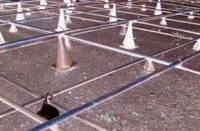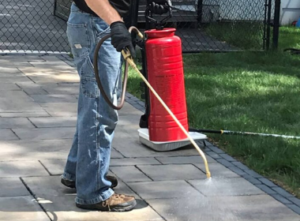
Applying stains and sealers with spray equipment may strike the decorative concrete contractor as a convenient, speedy solution, not terribly complicated.
But not so fast, say experts. The array of spray equipment for stains and sealers is quite diverse, and a one-size-fits-all approach is a recipe for problems, if not total disaster.
“The type and quality of sprayer is dictated by what is being sprayed,” says Chris Sullivan, ChemSystems Inc. vice president of sales and marketing. “Acid stain, for example, is usually applied by a plastic pump sprayer with no exposed metal that can be corroded by the acid in the stain. Most installers I have worked with use inexpensive sprayers for acid stain, as they tend to get contaminated and pretty beat up after one application.
“Nonreactive stains and dyes are best applied with sprayers that provide a finer mist and have tighter control of application rate,” he says, such as higher-end pump-up sprayers or airless and HVLP (high-volume, low-pressure) systems.
With sealers, controlling pressure and application rate is pivotal. Sullivan notes sprayers used for sealers are usually even higher in quality than those used for stains. Pump-up sprayers are the common choice, but airless and HVLP are becoming more popular.
“It’s important to note the type of sealer plays a large role in what type of sprayer to use,” he says. Solvent-based sealers require solvent-resistant parts in the sprayer. Higher-solids sealers (above 30 percent) require higher pressure than most pump-up sprayers can produce. This usually dictates a move to airless or HVLP systems for higher-solids sealers and coatings.
Aligning job size with sprayer capacity ranks high on the priority list, along with ensuring the sprayer parts are designed to handle the chemistry of the material being applied, says David Longfield, business development manager for RL Flo-Master.
Size does matter, he says, in that it’s much easier to spray a gallon of formula from a gallon sprayer than it is to spray a gallon of formula from a three-gallon sprayer — there’s less pumping. Then comes the choice of the correct spray tip.
Sprayers in action
Bob Harris — the Bob Vila of decorative concrete, you might say — demonstrates straightforward, informative techniques on using sprayers in videos posted on www.concretenetwork.com. Harris is the expert behind the Decorative Concrete Institute and a senior decorative concrete consultant for Structural Services Inc.
He says the type of sprayer is significant depending on the kind of material being applied. He urges users to read the fine print describing a specific sprayer and its uses. For instance, if a sprayer has acid-resistant seals, accompanying literature will note this.
There’s also the size of the project to consider. This figures into tank size, which is typically a gallon, two-gallon or quart.
Finally, there’s the shape of the sprayer’s tip that dictates the spray characteristics. A tip that produces a fine mist, for example, is typically used for acid stains, while a tip that generates higher volume is preferred for a water-borne stain or sealer.
When spraying acid stain or solvent-based dye, Harris likes to use a tip that has a round orifice that sprays the material in a conical fashion (in the shape of a cone) as opposed to a fan tip. With a fan tip, an outer spray pattern is usually evident, while with a conical tip you’re much less likely to see a spray pattern. To be safe, you should do a mock-up to determine which tip is best for the job.
Everybody’s favorite task — assembly — needs to be executed correctly. Safety equipment, such as glasses, respirator (OSHA-approved for airborne solvents) and nonabsorbent gloves, should be lined up ahead of time.
When applying a solvent-borne dye with a pump-up sprayer, Harris uses a bucket to check the spray stream to be sure it’s in working order. Then he pumps it up to pressurize the contents. When applying, a common mistake with a stain or dye is to squeeze the trigger and then let off, causing drips and splatter. “So don’t let off the trigger while applying,” he says. “Only let off when aiming back into the bucket.”
To remove anything that could clog the tip and spell disaster, strain the material into the tank before spraying. When done, wipe the tank’s rim so solvents don’t come into contact with the seals.
To get solvent-borne dye out of the sprayer, Harris recommends using acetone or xylene and then immediately flushing with water.
Using an HVLP
An HVLP cup sprayer, commonly used for walls or floors, revolves around a “high volume of material being sprayed at low pressure,” Harris says. The low pressure is important when applying so you don’t get airborne particles on adjacent finishes, furniture, and other surfaces or objects. That means around 10 pounds of pressure, depending on the type of material.
With an HVLP sprayer, an air feed is connected, and the spray pattern is adjusted as needed. One such tool, a gravity-fed cup gun, is often used with a traditional artist’s air brush, which enables the user to do very detailed work, such as graphics inside a rose petal or a leaf, with a lot of control and precision. “It’s fun to experiment with,” Harris says. Applying accents on previously dyed colors is a common use.
He emphasizes the importance of cleaning the sprayer after use, including the filter.
With this type of sprayer, Harris notes, the air pressure is constant, and the stain or dye is applied when the trigger is squeezed. Practice is important in working to fine-tune the amount of color desired. It can be used to create special effects. If an applicator lightly “fogs” on a color by setting the pressure very low, around 2 pounds, it can result in a rock-like textured appearance.
Cleaning with the proper solvent is actually a relatively quick process, and will keep the sprayer working for a long time. Water-based materials can be cleaned with simple soap and water. Solvent-based materials require a solvent such as acetone or xylene. But you can’t just fill the tank. The cleaning agent has to be run through the sprayer. It’s also not a bad idea to remove the tips and clean them separately from time to time to prevent material buildup.



















